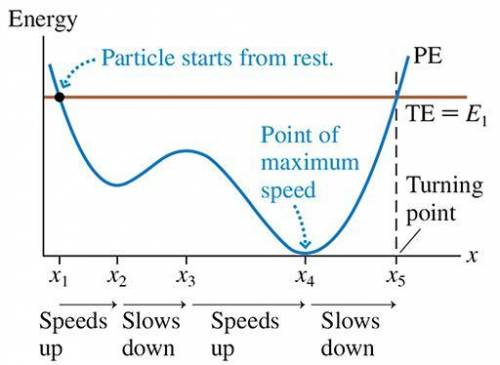
Physics, 10.10.2021 21:30 ButterflyEVE
Figure 10.20 in your textbook shows an energy diagram for a system with total energy E1. Suppose the system's total energy is E2 = (1/3)E1. In what ways could the particle move?
Select all that apply.
a.) It could remain at rest at x3.
b.) It could oscillate between x1 and x5.
c.) It could undergo small oscillations around x2.
d.) It could undergo small oscillations around x3.
e.) It could undergo small oscillations around x4.
Please explain why, I have an exam coming up and want to understand the concept.


Answers: 2
Another question on Physics

Physics, 21.06.2019 16:30
Which of the following would not be taken into consideration when describing the quality of a sound
Answers: 2

Physics, 21.06.2019 22:30
Follow these directions and answer the questions. 1. shine a pencil-thin beam of light on a mirror perpendicular to its surface. (if you don't have a laser light as suggested in the video, you can make a narrow beam from a flashlight by making a cone from black construction paper and taping it over the face of the flashlight.) how does the light reflect? how does the relationship of incident to reflected ray relate to the reflection of water waves moving perpendicular to a barrier? 2. shine a pencil-thin beam of light on a mirror standing on a sheet of paper on the table (or floor) so that you can mark the incident ray and reflected ray. (you can support the mirror from the back by taping it to a wooden block.) 3. mark a line on the paper representing the reflective surface. (the reflective surface of a mirror is usually the back edge.) 4. draw a dashed line perpendicular to the mirror surface at a point where the incident and reflected ray meet. this perpendicular is called a normal to the surface. 5. measure the angles between the rays and the normal. the angle of incidence is the angle formed by the incident ray and the normal to the surface. the angle formed by the reflected ray and normal is called the angle of reflection (r). what is the angle of incidence? what is the angle of reflection? 6. repeat for several different angles. (see report sheet for details.) what appears to be the relationship between the angle of incidence and angle of reflection? in science 1204, what was the relationship for these two angles made by the reflection of waves in a ripple tank? 7. roll a ball bearing so that it hits a fixed, hard surface (a metal plate) at several angles (including head-on). observe the way in which the ball bearing reflects. what generalization can you make about how a ball bearing reflects from a wall? have you proved that light can only behave like a wave?
Answers: 1

Physics, 22.06.2019 09:40
(a) assume the equation x = at^3 + bt describes the motion of a particular object, with x having the dimension of length and t having the dimension of time. determine the dimensions of the constants a and b. (use the following as necessary: l and t, where l is the unit of length and t is the unit of time.) (b) determine the dimensions of the derivative dx/dt = 3at^2 + b. (use the following as necessary: l and t, where l is the unit of length and t is the unit of time.)
Answers: 1

Physics, 22.06.2019 10:00
Abookcase has a mass of 38 kg and the coefficient of friction between it and the floor is 0.82 what is the maximum force of friction between the bookcase and the floor a 372n b 305n c 412n d 449n
Answers: 1
You know the right answer?
Figure 10.20 in your textbook shows an energy diagram for a system with total energy E1. Suppose the...
Questions

Mathematics, 19.03.2021 20:30


Mathematics, 19.03.2021 20:30


History, 19.03.2021 20:30

Mathematics, 19.03.2021 20:30


Mathematics, 19.03.2021 20:30

Mathematics, 19.03.2021 20:30

Chemistry, 19.03.2021 20:30


Mathematics, 19.03.2021 20:30


Mathematics, 19.03.2021 20:30



Mathematics, 19.03.2021 20:30





